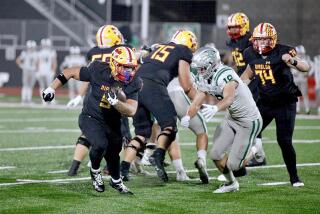It’s Something a Lot Like Football : Line Score for Summer Passing League: No Runs, No Hits, No Tackles, No Pads
- Share via
The L.A. Games official blew his whistle loudly and waved his arms like a man in a life raft trying to flag down a rescue boat. Action on the field between Hart and Canyon high schools came to an immediate halt.
“C’mon now, this isn’t football, “ the official screamed as he stepped off a five-yard penalty.
The target of his wrath, a muscle-hardened Hart linebacker in shorts and a T-shirt, had committed a major infraction: He’d touched the ballcarrier too hard. Pushed him, actually.
Moments later, a pass from Hart quarterback Jim Bonds was caught near the sideline and a Canyon defensive back downed the receiver with a soft shove. This time, the same official gave the defender a verbal warning.
“We didn’t get a warning,” a Hart coach yelled to the official. “The receiver was pushed. Call a penalty.”
The official shrugged and replied: “Coach, we’re playing football out here.”
So, was it or wasn’t it football?
It was 7-on-7, the un-football.
“You get some of the flavor of football in 7-on-7, but without the hitting,” Bonds said. “You throw a lot of passes and it’s a lot of fun. But that’s all it is.”
A close cousin to buttonhook-behind-the-Buick and streak-to-the-streetlight football, 7-on-7 offers high school teams a summer-long opportunity to hone the passing game.
“More teams than ever participate,” Birmingham Coach Alan Epstein said. “If you’re not doing something, someone else is doing it and they’re gonna get the edge.”
There are special rules to 7-on-7, most of them concerning no-no’s. No pads are worn. No blocks, pass rushes or running plays are allowed. All that’s added are skinned knees.
Centers are the only interior linemen on the field, and they just snap the ball and stand around. Guards and tackles pump iron while 7-on-7 players prance around the field.
Defensive players must line up at least five yards off the line of scrimmage. Quarterbacks have 3.5 seconds to release a pass or an automatic sack is called.
“There are problems with the rules and there are ways to cheat,” Epstein said. “But we try to make it as realistic as possible.”
Still, 7-on-7 is about as close to football as over-the-line is to baseball or H-O-R-S-E is to basketball. Despite the game’s artificial nature, most schools have a full summer schedule of 7-on-7. Why is it so popular?
“Timing is so important to the passing game, and 7-on-7 really helps in that area,” Westlake Coach George Contreras said. “And you do a lot of personnel evaluation of skill position kids.
“Seven-on-seven has accelerated the development of the passing game. People comment on how teams in Southern California are more advanced passing-wise than anywhere in the country. It’s due in large part to 7-on-7.”
The most active 7-on-7 teams play 30 to 35 games a summer. For the most part, coaches contact one another on an informal basis to schedule games. Birmingham plays host to a 7-on-7 league each May, and another league, run by Sylmar Coach Tom Richards, plays its games on Tuesday and Thursday evenings.
Seven-on-seven has been an event in the L.A. Games since 1971, and there are several one-day tournaments, including one today at Hart.
Coaches claim that trips to tournaments build camaraderie as well as sharpen skills. Westlake travels to Big Bear and Visalia for games each summer.
“We were going to cut down on our games this year,” Contreras said. “My players said, ‘OK, but we’re still going to the Big Bear tournament, aren’t we?,’ and, ‘We’re still going to Visalia, aren’t we?’ It turned out, we couldn’t cut back.”
At Westlake, the overnight 7-on-7 trips have become somewhat legendary.
“We had a situation one year at Big Bear where the kids were playing army during the middle of the night, and one kid thought he saw our quarterback standing by a tree,” Contreras recalled. “He ran up behind him, gave him a bear hug and said, ‘Gotcha, Jim.’ Well, there was also an international Hell’s Angels convention that weekend, and the guy he grabbed wasn’t the quarterback, it was a biker, who said, ‘Better sleep lightly, pal.’ ”
Canyon also combines football with fun. “We go to Carpinteria every year, play some games, then spend the day at the beach,” Canyon Coach Harry Welch said. “Girlfriends drive up with the guys and we have a barbecue. We’re interacting in an informal atmosphere. It’s very pleasurable.”
The games themselves are less intense than the regular season. When a player makes a mistake, a coach often will walk his team through the play with the cooperation of the opposing team.
“There’s a lot less stress than during the season,” Contreras said. “You can tell a guy on another team, ‘Great catch.’ It’s a friendly competitive situation, more of what sports are supposed to be.”
But does 7-on-7 prepare a team for football season? Coaches say it depends on the approach one takes.
“My philosophy is to get as many games as possible for quarterback and wide receivers’ timing,” Epstein said. “I’m looking at new kids and teaching the skills of running routes and catching the ball. On defense, it’s a tremendous opportunity to see which kids are developing, who can go to the ball. We work on footwork, zone defense, alignments and assignments. There is a lot of value to 7-on-7 if it’s used properly.”
Evaluating personnel is a primary use of 7-on-7, but coaches admit the science can be tricky. A tiger in shorts may turn into a pussycat in pads.
“You get about a 90% accuracy on personnel evaluation,” Contreras said. “Ten percent or so will look bad or great in the summer and the opposite in the fall.”
Said Epstein: “Sometimes they fool you. You’ll have a great 7-on-7 player who won’t hit once we put on the pads.”
For that reason, some coaches don’t mind 7-on-7 games getting a little rough. “There is some ferocious hitting without pads,” Epstein said. “The game of football is not for sissies and that’s something you have to instill. As a coach, you’re looking for tenacity and toughness.”
The sheer volume of games offers opportunities for players who might otherwise be overlooked. Thousand Oaks Coach Bob Richards said the skill of defensive back Rick Strickland became apparent during 7-on-7 games.
Strickland, a senior last season who was the defensive most valuable player in the recent Ventura County all-star game, became an all-league defensive back after not playing as a junior.
“At the end of spring ball, Ricky Strickland was not expected to be a starter,” Richards said. “He won a shot by what he did during the summer. I like to see what an inexperienced kid can do with a group of starters. I don’t put seven second-stringers on the field at once. “
As long as both teams are content with preparing for the regular season and evaluating talent, 7-on-7 is useful. Some coaches are consumed with winning, however, which can render the game less than a reasonable simulation of football.
“You like to win whether its checkers, chess or jumping in the pool backwards,” Epstein said. “Some guys overdo it. That’s when 7-on-7 loses its purpose.”
Said Welch: “One of the problems is that in 7-on-7 it is very common to send out all five receivers. You see coaches drawing plays on the ground. It can turn into street football.”
Epstein becomes upset when opposing teams use plays that would never work during the season.
“Why do something you’ll never do in the fall?” he said. “That’s what’s crazy about it. I’ve seen teams do things and I know damn well they won’t use that formation in a game.”
Teams that run an option or utilize play-action passes are at a disadvantage in 7-on-7. Coaches say they have to resist the temptation to abandon their offense and have their quarterback drop back to pass.
“Our offense is based on people honoring the running game,” said Contreras, who employs a Delaware Wing-T at Westlake. “It would be easy to say, ‘Forget the fakes. Let’s drop back and throw the ball.’ But that won’t help us win in the fall.
“Another problem, a real negative of 7-on-7, is that the quarterback can’t run with the football. Outside linebackers drop with the pass on sprint-outs. That’s a key for the QB to run but, in 7-on-7, he has to pass. So he’s actually making the wrong decision. We have to go right back to the sprint-out during the first few days of pads and start making the proper decisions.”
Thousand Oaks’ passing game is also built primarily on play-action and quarterback sprint-outs. Richards likes his team to play plenty during the summer, but admitted that the results during the fall are what count.
“Everything we do in 7-on-7 is designed to help us win in the fall,” Richards said. “We run our pure offense and defense even though most of our passes are play action. In 7-on-7, play action doesn’t hold the linebackers.”
Success during the summer may cause a coach to call more passing plays during the regular season.
“We open up more in the fall after a good summer,” Epstein said. “It’s subliminal. You and the kids remember that in passing league there was a critical situation and a certain play was open and it worked.”
A team’s 7-on-7 record is perhaps even less an indicator of success during the regular season than a pro baseball team’s spring training record. Richards, in fact, claims there is an inverse relationship between success in the summer and in the fall.
“Thousand Oaks has won six league titles in 14 years and the only year we had a winning record in 7-on-7 was 1975,” he said, “The team that fall went 1-8.”
Said Hart Coach Rick Scott: “It’s true that nobody remembers 7-on-7 scores when September rolls around. But it’s always fun to win. You just can’t really call it football.”
At least not without blocks, tackles and pads.
Special Rules for 7-on-7: 1. No pads are worn. 2. No offensive guard or tackles or defensive linemen are used. 3. Defensive players must line up at least five yards off the ball. 4. No blocking or rushing the passer is allowed. 6. No running plays except a draw up the middle are allowed. 7. No tackling or pushing is allowed. Ball-carrier is downed by a one-handed touch. 8. Passer has 3.5 seconds to release the ball from the time it is snapped. 9. Teams must gain 20 yards in 4 downs for a first down. 10.There are no kicks. If a team elects to punt on fourth down, the ball is advanced 35 yards.
More to Read
Get our high school sports newsletter
Prep Rally is devoted to the SoCal high school sports experience, bringing you scores, stories and a behind-the-scenes look at what makes prep sports so popular.
You may occasionally receive promotional content from the Los Angeles Times.






